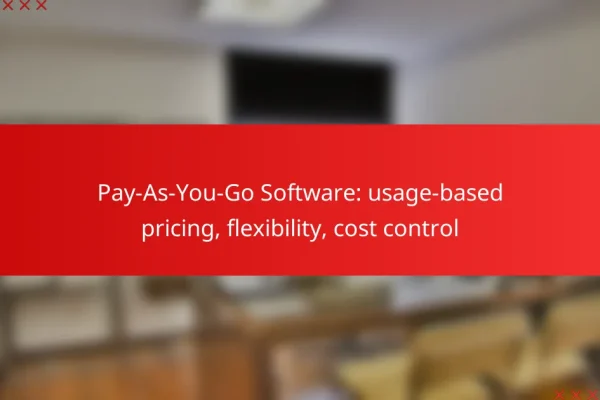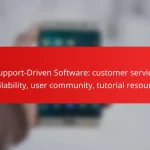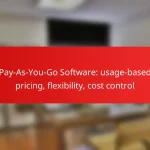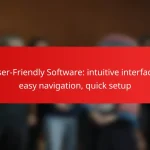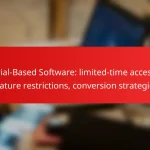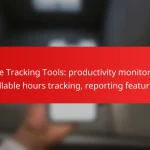What are the costs of handheld software in the US?
The costs of handheld software in the US can vary significantly based on several factors, including development, licensing, maintenance, cloud services, and integration. Understanding these costs is essential for budgeting and planning effective software solutions.
Development costs
Development costs for handheld software typically range from several thousand to hundreds of thousands of dollars, depending on complexity and features. Factors influencing these costs include the platform (iOS, Android, etc.), the development team’s expertise, and the project timeline.
For example, a simple app may cost around $10,000 to $50,000, while a more complex application with advanced features could exceed $100,000. It’s crucial to obtain detailed quotes from multiple developers to ensure competitive pricing.
Licensing fees
Licensing fees for handheld software can vary widely based on the software type and usage model. Some applications may require a one-time purchase, while others operate on a subscription basis, costing anywhere from a few dollars to several hundred dollars per month.
When considering licensing, evaluate whether the software is proprietary or open-source, as this can significantly impact long-term costs. Always read the licensing agreements carefully to understand any potential hidden fees.
Maintenance expenses
Maintenance expenses for handheld software are an ongoing cost that should not be overlooked. These costs typically range from 15% to 20% of the initial development cost annually, covering updates, bug fixes, and support.
Regular maintenance is essential to ensure the software remains compatible with new operating system versions and devices. Budgeting for these expenses can help avoid unexpected costs down the line.
Cloud service charges
Cloud service charges can add to the overall cost of handheld software, especially if the application relies on cloud storage or processing. These fees can range from a few dollars per month for basic services to hundreds of dollars for more extensive usage.
Consider the volume of data and number of users when estimating cloud service costs. Many providers offer tiered pricing models, so analyzing your needs can help you choose the most cost-effective option.
Integration costs
Integration costs involve connecting handheld software with other systems or services, which can be a significant expense. These costs can vary based on the complexity of the integration and the number of systems involved.
For instance, integrating with existing databases or third-party APIs may incur costs ranging from a few thousand dollars to tens of thousands. It’s advisable to plan for these costs early in the development process to ensure a smooth implementation.
How do subscription models affect pricing?
Subscription models significantly influence the pricing of handheld software by providing flexibility and varying payment options. Users can choose plans that best fit their needs, impacting overall costs and access to features.
Monthly vs annual subscriptions
Monthly subscriptions typically offer lower upfront costs, allowing users to pay a smaller amount each month. However, annual subscriptions often provide a discount, resulting in savings over the year, making them a more economical choice for long-term users.
For example, a monthly plan might cost around $10, while an annual plan could be priced at $100, effectively reducing the monthly cost to about $8.33 when paid annually.
Tiered pricing structures
Tiered pricing structures allow users to select from multiple levels of service, each with different features and price points. This model caters to various user needs, from basic functionality to advanced capabilities.
For instance, a basic tier might cost $5 per month, while a premium tier could be $20 per month, offering additional features like enhanced support or exclusive content. This approach enables users to pay only for what they require.
Free trial options
Free trial options are a common feature in subscription models, allowing users to test the software before committing financially. These trials typically last from a week to a month, providing a risk-free opportunity to evaluate the product.
When considering a subscription, take advantage of free trials to assess usability and features. Just be mindful of cancellation deadlines to avoid unexpected charges once the trial period ends.
What factors influence handheld software pricing?
Handheld software pricing is primarily influenced by the feature set, user base size, and market competition. Understanding these factors can help developers and businesses set competitive prices while ensuring value for users.
Feature set
The feature set of handheld software significantly impacts its pricing. More advanced features, such as enhanced security, offline capabilities, or integration with other applications, typically lead to higher costs. For instance, software that includes real-time data syncing or customizable interfaces may be priced in the higher range, while basic applications with limited functions are often more affordable.
When evaluating software, consider what features are essential for your needs. A simple app for note-taking might cost less than a comprehensive project management tool with collaboration features. Prioritizing necessary functionalities can help in selecting software that fits both budget and requirements.
User base size
The size of the user base can influence pricing strategies for handheld software. Applications designed for a larger audience often have lower prices due to economies of scale, while niche software targeting specific industries may command higher prices. For example, a popular fitness tracking app may offer a free version with in-app purchases, while specialized medical software might require a significant upfront investment.
When assessing software options, consider the potential user base. If you are developing an app for a small community, pricing may need to reflect the limited market size, which could lead to higher per-user costs. Conversely, software aimed at a broad demographic can leverage volume sales to keep prices competitive.
Market competition
Market competition plays a crucial role in determining handheld software prices. In a crowded market, developers may lower prices to attract users, while unique offerings can justify premium pricing. For instance, if several apps provide similar functionalities, the one with the best user experience or additional features may stand out, allowing it to maintain a higher price point.
To navigate competitive pricing, conduct market research to understand what similar software charges. This can help in positioning your product effectively. Avoid underpricing, as it may devalue your software, but also be cautious of overpricing without clear differentiation from competitors.
How can businesses estimate their budget for handheld software?
Businesses can estimate their budget for handheld software by considering development costs, ongoing maintenance, and potential return on investment. A thorough analysis of these elements helps in creating a realistic financial plan that aligns with business goals.
Cost estimation frameworks
Cost estimation frameworks provide structured approaches to calculate the expenses associated with handheld software. Common frameworks include top-down and bottom-up estimations, where top-down involves starting with a total budget and breaking it down, while bottom-up starts with individual components and aggregates them.
When using these frameworks, consider factors like development time, team expertise, and technology stack. For example, a basic app might cost anywhere from a few thousand to tens of thousands of USD, depending on complexity and features.
ROI calculations
Calculating return on investment (ROI) for handheld software involves assessing the financial benefits against the costs incurred. A simple formula is (Net Profit / Cost of Investment) x 100, which provides a percentage that indicates profitability.
To effectively calculate ROI, consider both direct revenue generation and indirect benefits, such as improved efficiency or customer satisfaction. For instance, if a handheld app costs 20,000 USD to develop and generates an additional 50,000 USD in revenue, the ROI would be 150%.
What are the hidden costs of handheld software?
Hidden costs of handheld software can significantly impact your overall budget. These costs often include training, ongoing support, and data migration, which are not always apparent during the initial purchase phase.
Training expenses
Training expenses can vary widely depending on the complexity of the software and the number of users. Organizations may need to invest in formal training sessions, online courses, or even hiring external trainers, which can range from a few hundred to several thousand dollars.
Consider the time employees will spend learning the new system, which can lead to lost productivity. It’s essential to budget for both initial training and potential refresher courses as software updates occur.
Support and updates
Support and updates are ongoing costs that can add up over time. Many software providers offer tiered support plans, which may include basic assistance or more comprehensive services, often costing between 15-20% of the software’s initial price annually.
Regular updates are crucial for security and functionality but may require additional fees or subscriptions. Ensure you understand the terms of your support agreement to avoid unexpected expenses.
Data migration costs
Data migration costs can be substantial, especially if you are transitioning from an outdated system. This process often involves data cleansing, mapping, and integration, which can require specialized skills and tools, leading to costs in the low thousands of dollars.
It’s advisable to assess your existing data quality and the complexity of the migration early on. Planning for these costs can help you avoid budget overruns and ensure a smoother transition to the new software.
What are the benefits of investing in handheld software?
Investing in handheld software can significantly enhance operational efficiency and user experience. These applications streamline tasks, improve accessibility, and often lead to cost savings over time.
Increased productivity
Handheld software boosts productivity by enabling users to perform tasks more efficiently and effectively. With features designed for mobile use, employees can access critical information and complete work from virtually anywhere.
For example, a sales representative using a handheld application can update client information in real-time while on the go, reducing the time spent on administrative tasks. This immediate access to data can lead to quicker decision-making and improved customer interactions.
To maximize productivity gains, businesses should ensure that the software is user-friendly and integrates seamlessly with existing systems. Regular training and updates can help staff leverage the full potential of the handheld software, avoiding common pitfalls such as underutilization or resistance to change.
